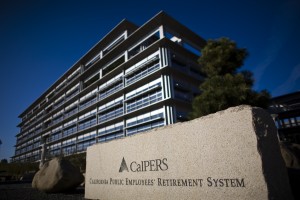
- Hypothetical benchmark would list ideal terms and conditions
- Would allow pension to see how terms “measure up”
- CalPERS also considers peer benchmark and target IRR for portfolio
The California Public Employees’ Retirement System reviewed an array of alternative benchmarks for its private equity portfolio at its January 19 meeting, including a possible standard for fund terms and conditions.
According to spokesman Joe DeAnda, a potential benchmark could detail a list of ideal terms and conditions that would allow the pension to see “how actual terms and conditions of our investments measure up.” That said, such a benchmark remains hypothetical.
“This isn’t a formal discussion about changing the benchmark,” DeAnda said in an email. “That may come down the line, but no decisions are being made today.”
Private equity fund terms and fees were a divisive issue for California’s $276.4 billion pension system in 2015. While the asset class delivered strong returns for much of CalPERS’ history, it often did so at a very high cost.
CalPERS’ $27.3 billion private equity portfolio netted a 12.3 percent return on a 20-year annualized basis, better than any other asset class, but staff estimates that general partners lopped off more than a third of the portfolio’s gross return for fees, carried interest and other expenses, according to pension documents. For comparison, public equities netted CalPERS an 8.2 percent return over the same period, and fees ate up just 0.04 percentage points of public equity’s gross return.
Even without a benchmark for acceptable fund terms, the retirement system managed to find success in bringing down private equity’s costs in recent years. The average management fee charged by GPs fell from 1.22 percent to 1.12 percent between the 2012-2013 and 2014-2015 fiscal years, according to pension documents. The average carried interest taken by fund managers fell from 16.92 percent to 14.8 percent over the same period.
In addition to discussing a possible standard for fund terms, CalPERS also reviewed other private equity benchmarks that may paint a fuller picture of its performance, including a State Street Private Equity Index that would measure the portfolio against a peer group. CalPERS also considered setting an internal rate of return target for its portfolio.
Currently, CalPERS measures its private equity portfolio against a blended FTSE Russell public equity index plus 3 percentage points. The blended FTSE benchmark does not adequately depict the private equity portfolio’s performance, according to pension documents and statements from CalPERS staff.
Investment staff members have said on several occasions the benchmark needs to be reviewed, most recently in November, when Investment Director Sarah Corr said there is a “mismatch” between the FTSE benchmark’s underlying assets and CalPERS’s private equity portfolio.
“It demonstrates the challenge of using a public market benchmark for private market portfolio analysis,” Corr said.
The portfolio failed to beat the benchmark in each of the three previous fiscal years. CalPERS underperformed its previous private equity benchmark, the Wilshire 2500 index plus 3 percentage points, in the 2010-2011 fiscal year.
Last month, The Los Angeles Times and other outlets reported CalPERS planned to drop its benchmark at its December meeting. The pension did not consider any changes to the benchmark at the meeting.
CalPERS had a 10.1 percent allocation to private equity as of September 30, according to its website. The pension was slightly above its 10 percent strategic target for the asset class.
Correction: An earlier version of this story incorrectly stated CalPERS staff’s assessment of the FTSE benchmark adequately reflected private equity performance. Staff believes it does not. The story has been updated.
Action Item: To view CalPERS investment portfolio priorities visit: http://bit.ly/1lvIW3l
Photo: Calpers headquarters is seen in Sacramento, California, October 21, 2009. REUTERS/Max Whittaker


 If you do not receive this within five minutes, please try and sign in again. If the problem persists, please
email:
If you do not receive this within five minutes, please try and sign in again. If the problem persists, please
email: